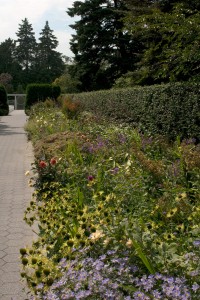Tip of the Week: Use Seasonal Walk as Design Teaching Tool
Posted in Gardening Tips on September 21 2009, by Sonia Uyterhoeven
 |
Sonia Uyterhoeven is Gardener for Public Education. Join her each weekend for home gardening demonstrations on a variety of topics in the Home Gardening Center. |
 Traditionally, Seasonal Walk at The New York Botanical Garden has been a display of annuals, which kicked off with a massive colorful showing of tulips in spring and reached a crescendo in the summer with an imaginative arrangement of summer tropicals. The season closed with an autumnal mix of mums (Chrysanthemum) and ornamental cabbages (Brassica spp.).
Traditionally, Seasonal Walk at The New York Botanical Garden has been a display of annuals, which kicked off with a massive colorful showing of tulips in spring and reached a crescendo in the summer with an imaginative arrangement of summer tropicals. The season closed with an autumnal mix of mums (Chrysanthemum) and ornamental cabbages (Brassica spp.).
For this year’s Seasonal Walk, the renowned Dutch designers Piet Oudolf and Jacqueline van der Kloet were invited to create a display that drew upon their areas of expertise: perennials, ornamental grasses, and bulbs. The result has been a transformation of the annual border into a multi-seasonal herbaceous paradise. Following, we explore some of the lessons that a design project of this scope has to offer the home gardener.
One feature that is immediately recognizable in the border is the intermingling of permanent and ephemeral plant masses. Perennials are skillfully placed in drifts that flow through the border. They hold the space in the spring as they slowly emerge and fill out until they are cut back as late as possible at the end of the season. They form the structural component in the border.
Tucked in the perennial drifts are irregular shapes that have been left open for the more ephemeral displays—tulips in the spring and annuals and tender bulbs in the summer. While these areas have irregular shapes—they are referred to as batwings and peanuts based on their form— the same shapes are repeated throughout the border, giving a sense of continuity that is important in any good design.
Part of the Dutch team’s talent is how they combined both the permanent and temporary features of the garden effortlessly so that they look like a cohesive whole. The annual and perennial features are woven together in such a way that one spills upon another in a seamless fashion.
For the home gardener, this is something to emulate. In garden design, planning starts with the planting—leave open spaces (drifts) in your perennial border that can be filled with annuals. The annuals do not have to be at the front of the border in a stiff, uniform fashion; rather, they can flow freely through the border, weaving from the front to the middle of the border.
One of the hallmarks of Piet Oudolf’s design is mass planting, using large blocks of perennials and grasses for color and impact. In some of his drifts these textural and colorful blocks are a partnership of two of three perennials that intermarry. In other spaces, the perennials fly solo to create a solid mass.
Gardeners should not be intimidated by the opulent display found on Seasonal Walk. The artistry of the designers’ skill in combining plants is at times overwhelming and inspiring, yet the principles are within everyone’s reach.
The average gardener will not have the space that Oudolf and van der Kloet had to work with. One solution is to take the principles of planting in drifts (some with one perennial, others with combinations of a few select plants) and simply reduce the numbers that comprise a drift. For instance, instead of planting a mass of nine Helenium ‘Moerheim Beauty’, plant three to five. Downsize a duo of seven Geum ‘Flames of Passion’ and eight Phlox divaricata ‘Clouds of Perfume’ to three and four, respectively.
Alternatively, if you are enamored by the mass planting effect, keep the large drifts and simply limit your plant palette. If the plants are combined as skillfully as done by the Dutch team, then a limited palette en masse will have just as much impact as the larger spectacle seen on Seasonal Walk.
I’ll continue to talk about the design of Seasonal Walk in my next post.

